Ken Roth Executive Director of Human Rights Watch is a Jew who's parents fled the Nazis in 1938.In his official bio he gives that as the reason he has dedicated him self to fighting Human Rights abuses all across the world. What his bio doesn't say is what has caused him to ignore Human Rights violations against Jews and why he runs an organization which uses falsehoods to slander Israel on an almost daily basis. But I think I know why, (and Don't worry Kenny boy ---you ARE getting your wish)
NGO Monitor's systematic and detailed analysis shows a significant increase in Human Rights Watch's focus on Israel in 2006, following a decline in 2005, and returning to the disproportionate agenda and lack of credibility characteristic of the 2000-2004 period. HRW publications dealing with Israel used unreliable and unverifiable "eyewitness" accounts, rather than photographic, documentary, or other evidence. These core deficiencies were particularly evident in its reporting on the July-August conflict with Hezbollah in Lebanon. Similarly, HRW continues to use the language of demonization with respect to Israel, compared to publications on other Middle East countries. The evidence in this report demonstrates that despite HRW’s recognition "that international standards of human rights apply to all people equally," this powerful NGO continues to promote an anti-Israel political agenda
Report on HRW’s Activities in 2006: Political Bias Undermines Human Rights
June 26, 2007

This report presents quantitative and qualitative (vocabulary-based) analyses of HRW publications regarding Israel, followed by detailed examples from individual publications issued in 2006. The report applies the methodology used in NGO Monitor's previous annual reports, based on a weighted scale for the ten different forms of publications produced by HRW. An analysis of HRW’s publications related to the conflict in Colombia and published by a research group at the University of London found similar political biases and lack of credibility. [1]
Quantitative Analysis: Focus on Israel Far Exceeds Other Middle East Countries
NGO Monitor's examination of HRW covering the years 2000-04 showed that a very clear and disproportionate level of HRW's resources were devoted to condemnations of Israel. There was a significant downward trend in 2005. (See report for details.) However, this trend was reversed in 2006, as the organization reverted back to its earlier pattern. While 8 percent of HRW publications and activities on the Middle East during 2005 focused on Israel, (59 of 702 points, as measured by the weighted method) in 2006, this jumped to 20 percent (223 of 1088 points). Indeed, Israel’s score far outweighed that of any other Middle Eastern country including Egypt (81 points), Libya (75 points), Saudi Arabia (47 points), and Syria (38 points). In other words, allegations against Israel received more than 6 times the attention from HRW than did Syria’s dictatorial regime that is being investigated by the UN for involvement in the assassination of Lebanese leaders, including former Prime Minister Rafik Hariri.
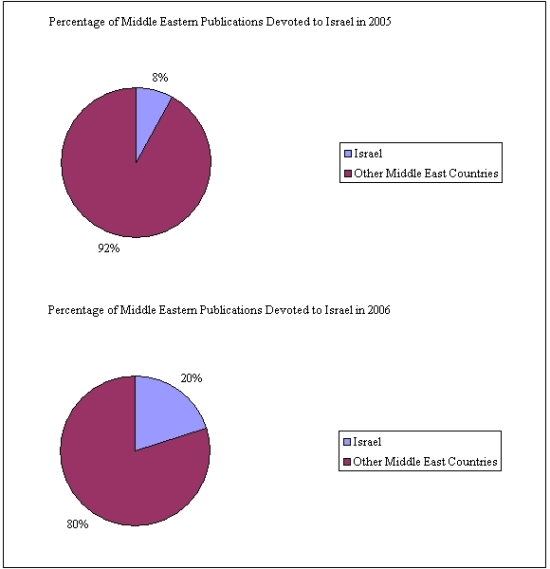
The following graph shows the weighted point totals for all Middle East countries in 2006:
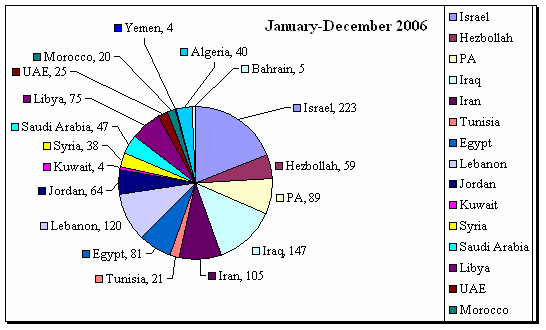
A large percentage of the increase between 2005 and 2006 can be attributed to HRW’s obsessive focus on Israel during the war with Hezbollah, with almost 30 publications issued (close to one per day), including reports, press releases, opeds, and letters. In contrast, if this period is removed from the annual total, HRW's relative focus on Israel was largely unchanged. In 2005, 8% of HRW publications on the Middle East (based on the weighted methodology) focused on Israel, and in 2006, 10% focused on Israel, excluding the five week war.
From this comparative perspective, HRW's disproportionate focus on Israel during the war appears to reflect a decision by its officials to use this event as an opportunity to return to their core political agenda, as displayed between 2000 and 2004. Over two-thirds of these publications on the war condemned Israeli responses to the Hezbollah attack, as shown in the following graph:
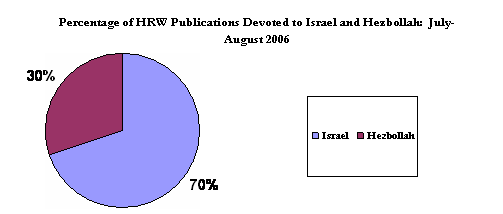
This extreme over-emphasis is particularly evident when comparing HRW's publications on Israel with publications regarding the conflict in Iraq.[2] According to the HRW World Report 2007, 1,000 civilians were killed in Lebanon during the Israel-Hezbollah War (July 12-August 14), while 5,000 were killed in Iraq during the months of July and August alone. Nonetheless, the following graph, using the weighted documents methodology, shows that HRW focused almost as much on the month-long war as it did on Iraq during the entire year: Similarly, during this same period (July 12-August 14, 2006), hundreds died in the fighting in Sri Lanka, but HRW issued only two minor press releases, and the ongoing brutality killing thousands in Darfur also received relatively little attention from HRW.
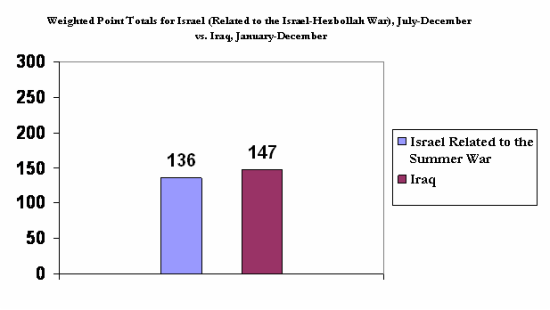
Language as a Reflection of HRW’s Political Agenda
In addition to the steady stream of press releases, opeds, statements, letters, and media interviews, HRW reports continued to reflect disproportionality, lack of universality, and inconsistency in reporting on Israel. For example, HRW's one major report on the Lebanon War was a 49-page document with the highly politicized and subjective headline, “Fatal Strikes: Israel’s Indiscriminate Attacks Against Civilians in Lebanon”. As reflected by this title, the report overwhelmingly highlights the condemnations of Israel, with only minor references to Hezbollah's violations of human rights, and no statements regarding aggression. As in many similar HRW reports in the past, (such as the organization's October 18, 2004 politicized report, "Razing Rafah: Mass Home Demolitions in the Gaza Strip" this report also erases the context, including Hezbollah’s aggression and its extensive use of human shields.
Peter Bouckaert, HRW's “emergencies director”, played a major role in HRW reporting on the war, and its institutional biases. On July 31, in The Guardian (UK), Bouckaert called Israel’s claim that Hezbollah used human shields a “convenient excuse.” Similarly, Ken Roth, HRW's Executive Director, wrote in the New York Sun on July 31, 2006 that Israel's actions in Lebanon during 2006 were "the morality of some more primitive moment." (Roth's offensive reference to the Biblical phrase "an eye for an eye" also demonstrated an immense ignorance.) These specific examples are further evidence of the violation of universality in the language used by HRW with respect to claims regarding human rights in the case of Israel, as demonstrated in previous NGO Monitor analyses.
In 2006, HRW publications also disproportionately and inconsistently applied international legal and human rights terminology. The terms “violation of international humanitarian law” and “violation of international human rights law” were utilized 30 times in its reporting on Israel, while only 19 such phrases were found in the case of Iraq. HRW officials also used “grave/serious Human Rights violations/abuses” 21 times regarding Israel, and 28 allegations that Israeli had acted "illegally" or "violated the law." These terms were used far less frequently by HRW with respect to Iran, Syria, Libya, Iraq and Saudi Arabia, despite routine and systematic human rights abuses practiced by these regimes. The following chart displays the number of times HRW cited each country with different terms in international law and IHL:
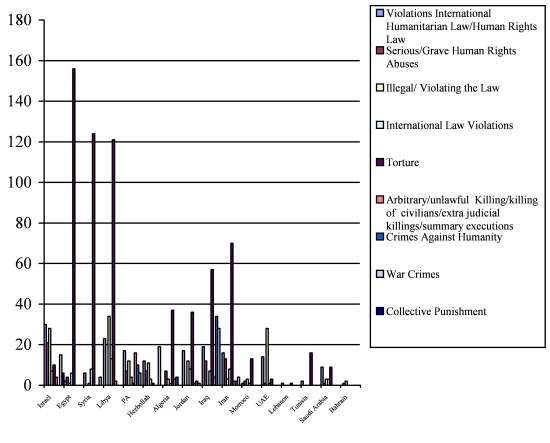
However, in other ways, HRW’s use of language reflects a somewhat more measured and judicious approach. For example, in 2005, HRW limited its use of “war crimes” exclusively to Israel, but in 2006, the term was used with respect seven countries in the region: Israel (15), Iraq (28), Iran (4), Jordan (1), Syria (4), PA(6), and Hezbollah (19[3]).
Nevertheless, when all the evidence of distorted language in HRW reports for 2006 is taken into account, the double standards and demonization of Israel are clear. In addition to the examples cited above, we note that:
- Israel was cited 30 times for “Violation International Humanitarian Law/ Human Rights Law” and Libya 23 times as opposed to 2 such citations for Egypt and 6 for Syria.
- Israel was cited 21 times for “grave/serious Human Rights violations/abuses” as opposed to 4 for Egypt and 0 each for Libya and Syria.
- Israel was cited 28 times for "illegal/violating the law" and Libya 34 times as opposed to 1 citation each for Syria and Egypt.
The following graph covering HRW publications for 2006 illustrates this systematic imbalance:
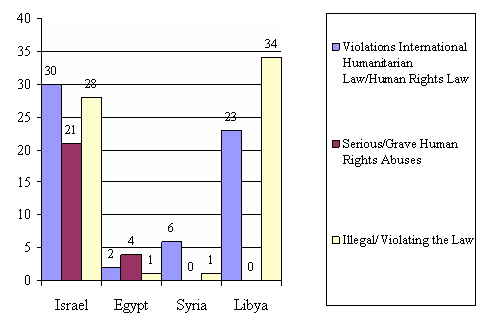
Erasing Aggression against Israel and Kidnapping from the Context
In addition to the statistical biases detailed above, HRW’s activities regarding Israel in 2006 focused on narrow issues that omitted the context of responses to attack. In this way, HRW has continued to be a central contributor to the Durban Strategy of delegitimizing Israel through the rhetoric of human rights.
For example, HRW's reporting systematically erased Hezbollah’s aggression and terrorism. Instead, HRW reports characterized Hezbollah as an “organized political Islamist group based in Lebanon, with a military arm and a civilian arm, and is represented in the Lebanese parliament and government.” This description also ignored Hezbollah's fortified underground positions along Israel’s northern border; the killing of Israeli soldiers and the kidnapping of their bodies in October 2000; repeated rocket attacks on Northern Israel, long after the May 2000 Israeli withdrawal from all of Lebanese territory and before the war, and similar events. In addition the kidnapping of Israeli soldiers by Hezbollah, igniting the war, and the refusal to allow visits by the International Committee for the Red Cross or any other contact, (clearly in violation of international law and human rights norms) were given very limited attention in HRW reports. Inexplicably, they were not labeled as aggression or violations of international law despite their clear status as such.
Following the war, The Intelligence and Terrorism Center at the Israeli Center for Special Studies (CSS) issued a detailed report on these events. It provides extensive documentation and photographic evidence of “Hezbollah’s consistent pattern of intentionally placing its fighters and weapons among civilians,” showing that Hezbollah was “well aware of the civilian casualties that would ensue” from this activity. The detailed evidence in this report stands in sharp contrast to the allegations by Human Rights Watch that it found “no cases” in which Hezbollah deliberately used civilians as human shields.Indeed, as noted, HRW officials even claimed that the assertions about Hezbollah’s use of human shields were merely a “convenient excuse” on Israel’s part to justify counter-attacks.
The “Evidence” Cited in HRW Reports on Israel Is Not Credible
During 2006, a systematic examination of the evidence presented in HRW publications that condemn Israeli actions determined that such evidence lacks credibility. For example, an HRW report regarding a July 16 Israeli air-strike in Lebanon following the kidnapping of the Israeli soldiers is based on claims from unnamed journalists, unnamed UNIFIL members, and Lebanese “eyewitnesses”. HRW does not state how these witnesses were selected, how many witnesses were interviewed, and whether any testimony was verified or discounted. Many HRW publications cite media reports without providing the publication details, date, or the authors, preventing independent verification. HRW does not specify whether any of its officials visited the site of an alleged attack, it does not identify the members of its team, how long the team was at the site, their language skills, or what investigative techniques it used.
This lack of detail is found in almost every report published by HRW during the war, and is characteristic of many previous HRW reports condemning Israel for alleged war crimes. And many of HRW’s claims in these reports are contradicted by far more credible evidence. NGO Monitor's December 28, 2006 report examining claims during the Lebanon war highlighted the contrast between the details in the C.S.S. report (cited above) and the publications of HRW and Amnesty International. For example, HRW repeated that "eyewitness" claimed that "there was no fighting taking place in [Bint Jbeil] there was no one but civilians. The civil defense was there to help us [recover the bodies]." The CSS report, on the other hand, showed 20 bases and 5 weapons storehouses, along with 87 rockets fired from within village houses, 109 from within a 200 meter radius of the village, and 136 within a 500 meter radius, in Bint Jbeil. The report also documented 60 regular Hezbollah operatives in the village, including about 15 in charge of the storehouses.
Similarly unreliable evidence was used in HRW’s highly publicized campaign regarding what has come to be known as “the Gaza beach incident”. On June 9, eight Palestinians were reportedly killed on a Gaza beach in disputed circumstances. Amnesty International and several Palestinian NGOs, including Miftah, Al Mezan and the Palestinian Centre for Human Rights issued condemnations of Israel in the days following. On June 12, the IDF concluded, based on detailed evidence including shrapnel removed from the victims taken to Israel for treatment, that the IDF was not responsible. On June 13, however, HRW presented the findings of Marc Garlasco, a former “battle damage expert,” in a widely publicized press conference in Gaza. Garlasco was also one of the authors of HRW’s "Razing Rafah" report of 2004, which contained many unverifiable and disputed claims, and was highly politicized. Ignoring contradictions in the evidence, and the apparently fabricated video that was released by the Palestinians, HRW declared that “the evidence overwhelmingly supports the allegations that the civilians were killed by artillery shells fired by the IDF”.
HRW’s lack of credibility was highlighted again on June 19 and 20. After a second press release on the incident was issued on June 15, Garlasco met with Maj.-General Meir Klifi for three hours on June 19 to discuss their investigations. Following the meeting, Garlasco told the Jerusalem Post that HRW could not contradict the findings of the Israeli inquiry and he claimed that the most likely source of the explosion was "unexploded Israeli ordinance." On June 20, however, HRW issued a third press release, claiming that the IDF investigation was “incomplete”, contradicting his statements to the Jerusalem Post, and called for an “independent inquiry.” (See NGO Monitor’s detailed timeline and report on NGOs reporting of the incident.)
HRW Flip-flops on Palestinian Use of Human Shields
On November 22, 2006, Human Rights Watch issued a press release condemning Hamas for calling on civilians to protect “fighters” engaged in attacking Israel and surrounded by the IDF. HRW noted that this call endangered civilian lives, constituting "at worst human shielding, at best failing to take all feasible precautions to protect civilians from the effects of attack". Following publication, radicalized NGOs and fringe political commentators -- including Palestinian NGOs PCHR, Al-Mezan, and Al-Dameer, and the anti-Zionist Norman Finkelstein (in Counterpunch) – criticized HRW, calling these Palestinian actions acts of “non-violent resistance” and pressured the organization to retract the statement. Rather than upholding the universality of human rights in this case, HRW changed its position in a December 16 press release and withdrew its condemnation.
In defending this reversal, HRW officials cited "factual" claims and the interpretation of international law. “We have since concluded that we were wrong, on the basis of the available evidence, to characterize the IDF’s planned destruction of the house as an act of war." The key “evidence” was again based on unnamed and unverifiable “eyewitnesses” and “journalists” undermining the credibility of HRW's new factual claims.
In examining HRW’s use of international legal categories, the initial statement argued "it is a war crime to seek to use the presence of civilians to render certain points or areas immune from military operations or to direct the movement of the civilian population or individual civilians in order to attempt to shield military objectives from attack." In the retraction, however, HRW chose to cite an entirely different legal dimension, arguing that if the Israeli government’s planned action was “aimed at punishing a militant for his alleged activities, the law regulating the conduct of hostilities during armed conflict would not apply and could not be violated.” Such a distinction is without a difference since under either interpretation, civilians were intentionally placed in harm’s way by Palestinian terrorist organizations.
From this record, it appears that the political and ideological criticism of HRW's initial statement pressured the organization into changing its stance. Unlike its swift reaction in this case, HRW has yet to issue a retraction or correction of its many condemnations of Israel both in the case of the false claims regarding anti-terror operations Jenin in 2002 and during the Lebanon War in 2006, even when faced with overwhelming evidence that its statements were false. [4] And HRW has not retracted or apologized for its errors regarding the UN Human Rights Council.
HRW Condemns Israel and the US for being Right about the UNHRC
In 2005, many UN members, with the active involvement of Secretary General Kofi Anan, acknowledged that United Nations Commission on Human Rights had been thoroughly discredited, and agreed to negotiate the creation of a United Nations Human Rights Council. However, the draft framework for the UNHRC that was presented in 2006 was seen by the American and Israeli governments as providing the basis for failure and the continued exploitation of human rights principles, including anti-Israel political campaigning.
HRW officials supported the adoption of the new framework, and condemned the efforts to change the terms in order prevent abuse. In March 2006, Human Rights Watch sent a letter to U.S. Secretary of State, Condoleeza Rice, "to urge that the United States support the draft resolution for a new U.N. Human Rights Council" as it is, claiming that delay would "weaken the resolution" or "delay its adoption indefinitely." The election of council members in May 2006 further highlighted the fact that the new UNHRC would not be better than the previous version. However, on May 9, 2006, in an interview on the BBC, Ken Roth declared that he had "every confidence" that the new council would condemn the violence in Darfur.
These predictions and HRW's attacks against those who warned of these dangers have proven to be totally wrongheaded. The new UNHRC has been even more active in false accusations and demonization against Israel than the previous discredited framework. This incident again highlights the dominance of HRW’s political agendas over the pursuit of universal human rights.
Conclusion
The evidence from 2006 indicates that despite limited movement towards greater universality in coverage of the Middle East, HRW officials continue to promote an anti-Israeli agenda, when the opportunity arises. The language used in HRW reports to condemn Israel continues to be excessive and highly disproportionate, in comparison with reports on other countries in the Middle East. This bias is inconsistent with the universality of human rights, thereby undermining these norms and their moral foundation.
Endnotes:
1. See the report published by Andres Ballesteros, Jorge Restrepo, Michael Spagat and Juan Vargas of the University of London and the Conflict Analysis Resource Center (CERAC), a Bogota-based research center. In their report, “The Work of Amnesty International and Human Rights Watch: Evidence from Colombia”, the authors state that Human Rights Watch's reports have a "non-systematic approach that includes opaque sourcing and frequent changes in the objects they measure" Moreover, they document that HRW “seldom define[s] the categories [it] report[s] on” and publishes on "only a few variables while others come and go from year to year . . . [which] complicates any effort to grasp changes over time in the HR environment." The report also documents HRW's tendency to "underestimate guerrilla killings."
2. Note that only statements regarding insurgents, rather than the policies of the United States or other countries with forces in Iraq, were included in NGO Monitor statistics and analysis on Iraq.
3. It is important to note that while HRW cited Israel 15 times for "war crimes" and Hezbollah 19 times, the impact of these condemnations of Israel was greater than the impact of its condemnations of Hezbollah. For example, 4 of the 19 citations of Hezbollah were in "Fatal Strikes: Israel's Indiscriminate Attacks against Civilians in Lebanon", the only major report published during the war. As the title shows, the report focuses almost entirely on allegations against Israel. Such condemnations against Hezbollah are therefore buried, minimizing their impact. In many other cases as well, condemnations of Israel were often more widely publicized than condemnations of Hezbollah or the PA. See this report's sections on the 2006 Lebanon War and the Gaza Beach Incident for more detail.
4. HRW exhibited a similar failure to acknowledge mistakes in its reporting on the bombing in Qana. On July 30, immediately following the attack, HRW issued a press release declaring that “at least 54 civilians have been killed.” On August 2, 2006, HRW revealed that its "preliminary" research yielded a casualty count of 28 – there are still conflicting reports on the details – yet nonetheless, the organization has failed to remove the original statement from its website. See Marvin Kalb of The John F. Kennedy School of Government-Harvard University's study, "The Israel-Hezbollah War of 2006: The Media as a weapon of Asymmetrical Conflict" for more information on HRW's premature casualty estimates regarding the bombing at Qana.
 I would like to make a special announcement the one Ken Roth has been working so hard towards...for almost 15 years of demonizing Israel. Ken Roth, son of the Shoah---> you are receiving a lifetime achievement award from the Self-Hating Jew Hall of fame. Yes because of your tireless service to creating more Dead Jews--you are recieving the coveted Shit Head award.... we have mocked up a picture of how it will look when you wear it--- congratulations and wear it in good health, you certainly are a fine example of what a shit head should be.
I would like to make a special announcement the one Ken Roth has been working so hard towards...for almost 15 years of demonizing Israel. Ken Roth, son of the Shoah---> you are receiving a lifetime achievement award from the Self-Hating Jew Hall of fame. Yes because of your tireless service to creating more Dead Jews--you are recieving the coveted Shit Head award.... we have mocked up a picture of how it will look when you wear it--- congratulations and wear it in good health, you certainly are a fine example of what a shit head should be.
No comments:
Post a Comment